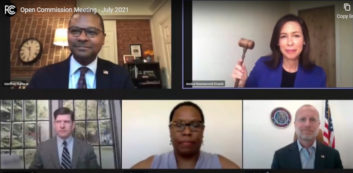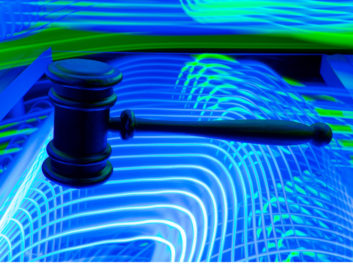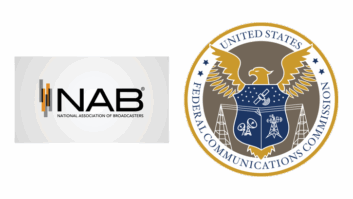
The FCC is moving to clean up more broadcast radio technical rules.
The four commissioners voted unanimously in July to adopt a Notice of Proposed Rulemaking that identifies seven technical rules they want to eliminate or at least revise. The vote, and the subsequent publication in the Federal Register, will start a public comment process toward final action.
Some changes are more significant than others, but radio observers told Radio World that all will benefit broadcasters and allow them to operate more efficiently.
[Read: Comment Deadlines Are Set in Tech Rule Review]
Former Chairman Ajit Pai made it a theme of his tenure to eliminate outdated and redundant technical provisions for broadcast radio stations. But acting Chairwoman Jessica Rosenworcel too has identified rules worth revising or trimming.
The proposed changes include clarifying some conflicting technical provisions, as well as eliminating the maximum rated transmitter power limit rule for AM stations.
The FCC believes the latter is “outdated and unnecessary,” given the commission’s reliance on actual operating antenna input power as the most accurate and effective means of ensuring that AM stations adhere to their authorized power limits.
The commission also wants to eliminate a requirement that applicants demonstrate the effect of any FM applicant transmitting antenna on nearby FM or TV broadcast antennas, calling this rule seldom used.
It also plans to update the noncommercial FM community of license coverage requirement to create consistency across different rules for NCE stations. Specifically, the FCC proposes that “the requirement that stations reach 50% of their community of license or 50% of the population in their community should replace the more general requirement that the NCE station cover a portion of the community.”
“Reasonable and Prudent”
Bob Weller, vice president for spectrum policy at the National Association of Broadcasters, says the association is working with its members to ascertain whether there are particular benefits or concerns about the FCC’s plans.
“Most of the proposed rule changes seem reasonable and prudent. It’s always good to eliminate or clarify rules that are in conflict with other rules. But we want to ensure that those internal conflicts are resolved in a way that no broadcasters are harmed,” Weller told Radio World in an email.
NAB expects to work with the FCC in its ongoing review of regulations and possibly comment in greater detail on one or two of the specific changes, Weller said.
Broadcast engineering experts contacted for this story generally are supportive about the cleanup.

One longtime observer of the commission said these updates are “safe and sane” deregulatory efforts and constitute a “clearing of regulatory underbrush” of outdated technical rules. “The changes being proposed appear to be mostly administrative in nature, harmonizing rules and eliminating inconsistencies from some areas and clarifying others,” according to this expert.
Veteran broadcast engineer Ben Dawson, consulting engineer with Hatfield & Dawson, said he is “delighted the FCC has set out to clean up” outdated broadcast rules, in particular the maximum rated transmitter power limit rule for AMs.
“No one has paid any attention to this rule for decades, and the transmitter manufacturers no longer design their products in the old power limit series anyway,” Dawson said.
Another rule that is mostly ignored, he said, is the requirement that applicants demonstrate the effect of any FM applicant’s transmitting antenna on nearby FM or TV broadcast antennas.
“It serves no useful purpose except in the rare case where there is a new installation that really does mess up an existing one — FM antennas improperly interleaved, for example,” he said.
However, one observer said that the “co-location rule” for FM stations provides legal teeth to a longstanding FCC policy that broadcasters who are “second in time” are “first in responsibility” to resolve interference problems due to proximity. “An FCC policy is subject change and may be difficult to enforce, while a rule carries clear legal standing,” he said.
Another FCC watcher, Chris Imlay, general counsel of the Society of Broadcast Engineers, said that efforts by the FCC to ease broadcast regulations and clean up old rules began in earnest during the Reagan administration.
“It was a feverish effort to pare away overly limiting broadcast rules, to try to get broadcasting closer to a print media level of regulation,” Imlay said.
“After that, the biennial review dockets looked for rules that were outdated or needed updating. Advances in the reliability of broadcast equipment and reliable automation justify elimination of outdated technical regulations to some extent,” Imlay said.
Update to a Fill-in
Imlay thinks the redefinition of AM fill-in areas will be perhaps the most helpful and relevant change.
The commission wants to amend the definition of an “AM fill-in area” when an FM translator simulcasts an AM station. It says its change would “create consistency” across different rules governing fill-in translator transmitter siting.
“It seems to me that by far, that’s the proposed rule change that will be most helpful, at least for AM radio broadcasters with FM translators,” he said.
“The rules have been inconsistent. Making these two rules consistent alleviates an anomaly that is confusing, to say the least.”
The FCC also plans to update the signal strength contour overlap requirements for noncommercial Class D FMs to bring those rules in line with the contour overlap requirements for all other noncommercial FMs.
The proposal states, “This change will allow Class D stations greater site selection flexibility as well as the opportunity to potentially increase their coverage areas.” The commission proposes that “the time is ripe to extend the otherwise universal 100 dBu contour overlap standard for second-adjacent channels to NCE FM Class D stations.”
The FCC believes the 100 dBu standard “is a better gauge of potential second-adjacent channel interference than the 80 dBu standard.”
According to Laura Mizrahi, vice president of the consulting firm Communication Technologies, “The NCE-FM Class D second adjacent channel interference ratio most definitely should be consistent with all other services. It’s been +40 dB or the 100 dBu interference contour for all other FM services for a long time now. High time to give the second-class Class Ds some relief here.”
Asked if these changes might mean a lot of new business for broadcast engineering consultants, she said no.
“There may be some modest increase, if only from a curiosity standpoint, from some Class Ds, but from my perspective there isn’t likely to be a huge influx of inquiries, since this would only benefit existing Class D facilities, of which it is believed very few would be able to benefit from the change.”
Border Issues
As part of the NPRM, the FCC is also seeking to eliminate a requirement for broadcasters to protect grandfathered common carrier services in Alaska operating in the 76–100 MHz frequency band, “since there are no common carrier services remaining in this band in Alaska,” according to the FCC.
The notice would also tweak allocation and power limitations for broadcast stations located within 320 kilometers, or about 199 miles, of the Mexican and Canadian borders.
Bert Goldman, president of Goldman Engineering Management, believes this particular update will affect broadcast licensees, particularly in the planning of translators.
“Codifying and updating some of the rules in Parts 73 and 74 will make things easier and will allow for some improvements of translators along the border. I have filed several translator applications near the Mexican border, and trying to decipher and apply the international treaty requirements for translators near the border is maddening,” Goldman said.
[Read: FCC Finalizes Changes to Part 95 Rules]
“These changes should simplify the application process and allow for more reasonable facilities.”
But Goldman is one of several observers who told Radio World they would like to see further action from the commission on outdated radio technical rules.
“I think it’s a good start, but they’re certainly not taking any risks. In my opinion, this NPRM is an attempt by the FCC to get something passed without creating a lot of pushback. It’s extremely benign,” Goldman said.
“I’d love to see the commission take on some really meaningful reregulation that helps broadcasters and consumers, and not just the biggest voices in the room.”
One industry veteran said he agrees that the rulemaking is conservative and not controversial. “This is what we have seen so far from Rosenworcel, who doesn’t want to rock the boat while an acting chairwoman,” that person said.
And Ben Dawson said the FCC should consider updating rule 73.51, which deals with determining operating power. “The only part worth retaining is a reworded section (e)(1), which would require use of the manufacturer’s stated final amplifier DC-to-RF efficiency factor.”
The text of the NPRM is on the Radio World website at https://tinyurl.com/rw-tech-rules. Interested parties may file comments and replies at www.fcc.gov/ecfs/filings. Specify proceeding MB Docket No. 21-263. Comment deadlines had not been published as of late July.







